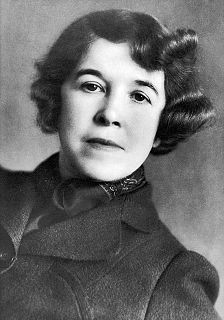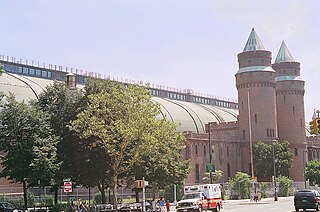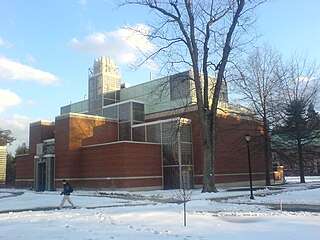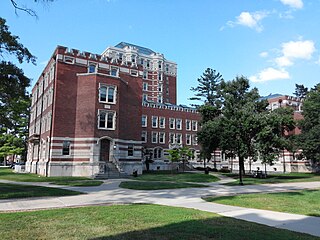
Vassar College is a private liberal arts college in Poughkeepsie, New York. Founded in 1861 by Matthew Vassar, it was the second degree-granting institution of higher education for women in the United States, closely following Elmira College. It became coeducational in 1969 and now has a gender ratio at the national average. The college is one of the historic Seven Sisters, the first elite women's colleges in the U.S., and has a historic relationship with Yale University, which suggested a merger before they both became coeducational institutions. About 2,450 students attend the college.

Hallie Flanagan Davis was an American theatrical producer and director, playwright, and author, best known as director of the Federal Theatre Project, a part of the Works Progress Administration (WPA).

York and Sawyer was an American architectural firm active between 1898 and 1949. The firms' work is exemplary of Beaux-Arts architecture as it was practiced in the United States. The partners Edward York and Philip Sawyer (1868–1949) both trained in the office of McKim, Mead & White in the 1890s. In 1898, they established their independent firm, based in New York City.

Strong House is a dormitory at Vassar College named after Bessie Rockefeller Strong, the oldest daughter of oil tycoon John D. Rockefeller, who was largely responsible for funding the building's construction. It used to be the only all female dormitory remaining after Vassar went coeducational in 1969. However, Strong House currently identifies as a gender inclusive dorm. The building was designed by Francis R. Allen and was completed in 1893.

The Vassar Chapel, built in 1904, is the main religious building at Vassar College, and is the largest religious edifice in Poughkeepsie, New York. Although it has been altered, repaired, and acoustically improved, it is one of the few buildings at Vassar that has not undergone considerable renovation. Each semester, the College community gathers in the Chapel for fall and spring convocations, in which the President and a notable member of the faculty deliver addresses.

Pilcher and Tachau was an American architectural firm in the late-nineteenth and early-twentieth-century New York City, and was the predecessor firm of Tachau and Vought. It was formed by Lewis Pilcher and William G. Tachau.

Can You Hear Their Voices? A Play of Our Time is a 1931 play by Hallie Flanagan and her former student Margaret Ellen Clifford, based on the short story "Can You Make Out Their Voices" by Whittaker Chambers. The play premiered at Vassar College on May 2, 1931, and ran most recently Off Broadway June 3–27, 2010. Broadway World notes that it anticipated John Steinbeck's The Grapes of Wrath and Clifford Odets' Waiting for Lefty, predating them by eight years and by four years respectively.
New York Stage and Film is an art and film institution founded in 1985 by Mark Linn-Baker, Max Mayer and Leslie Urdang in order to provide artists with a rigorous and nurturing environment to invigorate the artistic process; to promote collaboration between artistic peers and between artists and audiences; and to facilitate the sharing of knowledge from one artistic generation to the next. A non-profit company dedicated to both emerging and established artists in the development and production of theater and film, it is a vital incubator for artists and their work, a catalyst for stories that start with us and continue across the country and around the world.

Cushing House is a four-story co-ed dormitory on Vassar College's campus in the town of Poughkeepsie, New York. A response to freshmen overcrowding, the college's Board of Trustees hurried the Allen & Collens-designed building, named for college librarian and alumna trustee Florence M. Cushing, to construction and completion in 1927. Cushing was originally designed as eight smaller houses with euthenic principles in mind, but ended up as a single U-shaped dormitory in the Old English manor house style with Jacobean interior furnishings. Students of all grades may live in the house, which houses up to 202 in single, double, and triple rooms and are referred to as "Cushlings". Throughout Cushing's history, various proposals and plans have incited controversy among the building's residents, including designating one of its wings as all-black housing and converting one of its common areas into eight single rooms. Contemporary reviewers have looked favorably upon Cushing's aesthetic qualities, declaring it to be one of Vassar's most beautiful buildings.

The Seeley G. Mudd Chemistry Building was a chemistry laboratory and classroom building on the campus of Vassar College in the town of Poughkeepsie, New York. The 42,000-square-foot (3,900 m2) postmodern building stood on the north end of a cluster of other science buildings on the site of the school's first chemistry laboratory. It was completed in 1984 at a cost of $7.2 million after the college received money from a fund bequeathed to it in the will of California cardiologist and professor Seeley G. Mudd. The structure replaced Sanders Hall of Chemistry and included elements designed to be energy efficient, notably a large wall of glass blocks that designers hoped would passively heat the building. Reviews of the structure were positive when it opened with critics praising the way its form complemented nearby older buildings. By 2015, many aspects of the building had been evaluated as being in Fair or Poor condition and the building was demolished in April 2016 as part of the Science Center project, later replaced with an open green space.

Raymond House is one of five quadrangle residence halls at Vassar College, located in the town of Poughkeepsie, New York. Raymond House was erected in 1897 in response to the popularity of Strong House, and was promptly designed by Francis R. Allen. Named after the second president of Vassar College, John Howard Raymond, this dormitory has five floors and is one of the residence halls that was paid for by the college in entirety.

Lathrop House was the third quadrangle dormitory built on Vassar College's campus in the town of Poughkeepsie, New York. Constructed in 1901 and designed by Boston-based Allen & Vance, the brick dorm stands five stories tall. Lathrop houses 180 students who may be any year or gender.

The Philaletheis Society is a student theatre group at Vassar College in the town of Poughkeepsie, New York, and the school's oldest student organization. Founded in December 1865, Phil began as a college literary society and its first leader was college president John Howard Raymond. Control of the organization was swiftly handed to the students and the group split into three chapters, each with a distinct focus. The group maintained its literary focus until the 1890s, by which point dramatic productions had taken over in popularity. The tradition of producing four and later three plays per year continued into the mid-twentieth century, but in 1958, the organization disbanded due to lack of interest. It was revived in 1975, first as an arm of student government and then as an independent student organization.

The Class of 1951 Observatory is located near the eastern edge of the town of Poughkeepsie, New York, on Vassar College's campus.

Davison House is a five-story dormitory on the campus of Vassar College in the town of Poughkeepsie, New York. Designed by Boston architecture firm Allen & Vance and built 1902, it was the fourth dorm built on Vassar's residential quadrangle. It houses 191 students of any grade or gender and it became Vassar's first disabled-accessible dorm following a 2008–2009 renovation.

The Students' Building on the campus of Vassar College in the town of Poughkeepsie, New York, U.S., houses the school's All Campus Dining Center as well as additional multifunctional student space on its second floor. Designed by Joseph Herenden Clark of McKim, Mead & White and built in 1913, the structure originally housed a variety of different student organizations and school functions. In 1973, it was converted into a campuswide dining hall; it underwent a second renovation in 2003 that returned multipurpose student functionalities to its upper floors.

Jewett House is a nine-story Tudor-style dormitory on the campus of Vassar College in the town of Poughkeepsie, New York. Built in 1907 to accommodate increasing demand for residential space, the dorm was designed by Vassar art professor Lewis Pilcher of the architectural firm Pilcher and Tachau. Early reviews looked unfavorably upon Jewett, even dubbing it "Pilcher's Crime" and by 2002, a host of issues plagued the dorm, leading to a $21 million renovation. Up to 195 students of any gender or class year may live in Jewett, which has been purported to be haunted by several different ghosts during its existence.

The Fonteyn Kill is a 1.5-kilometer-long (0.93 mi) urban stream flowing through Dutchess County, New York, onto the campus of Vassar College, and into the Casperkill. The stream was first on land inhabited by the native Wappinger band before being transferred to the Dutch and then the British. A mill was built along the kill by 1714 and the stream's presence influenced Matthew Vassar's decision to locate his college in the area. The artificial Vassar Lake lies midway down the Fonteyn Kill and was once used for ice skating and boating.

Ely Hall is a two-story Richardsonian Romanesque classroom and laboratory building on the campus of Vassar College in the town of Poughkeepsie, New York, US. The structure houses Vassar's Department of Earth Science and Geography, the A. Scott Warthin, Jr. Museum of Geology and Natural History, and the Aula, a spacious and frequently used gathering space.
Dixie Sheridan is a photojournalist, based in New York City, specializing in the documentation of the performing arts, primarily theater, Off-Broadway and Off-Off-Broadway. The New York Public Library has acquired Sheridan's photographic archive for its New York Public Library for the Performing Arts, located at the Lincoln Center for the Performing Arts, where it will eventually be made available to the public.




















